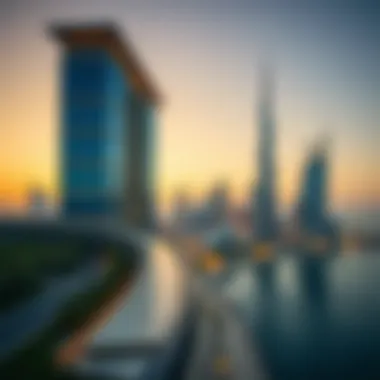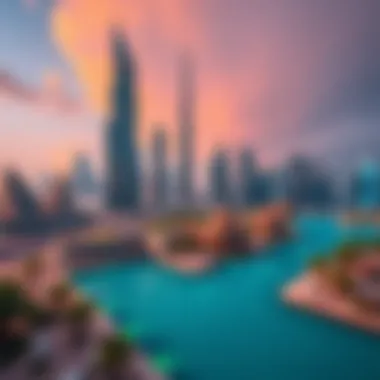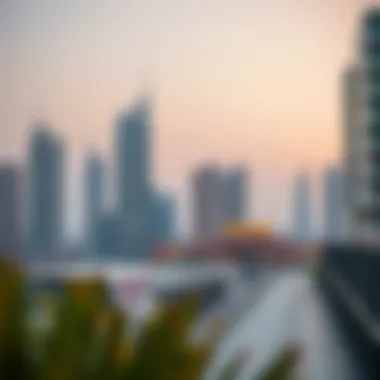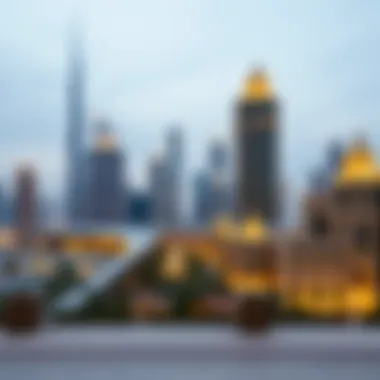Exploring Fairmont Dubai: Architecture and Culture


Intro
Dubai's skyline is a shimmering testament to architectural ambition and cultural synthesis, a balletic interplay of steel and glass that captivates anyone who sets eyes upon it. Among this modern marvels, the Fairmont Dubai stands tall, not only as a luxury hotel but also as a beacon of style and sophistication woven deeply into the fabric of the city. In this exploration, we shall probe into the distinctive features of the Fairmont’s design, uncover the reasons it captures the attention of visitors and residents alike, and understand its role in shaping the urban landscape and cultural narrative of Dubai.
As we journey through this multi-faceted narrative, readers will gain insights into the architectural nuances that set the Fairmont apart from its neighbors, the economic dimensions surrounding real estate as they pertain to the hotel, and the stakeholder perspectives that give voice to the building’s impact on community and tourism. The intersections of architecture and culture will provide the lens through which we explore not just the building itself, but the broader implications of such iconic structures in a rapidly developing urban environment.
With a joint emphasis on architectural significance and cultural meaning, this article seeks to illuminate the synergy between form and function, revealing how the Fairmont Dubai contributes to the ongoing dialogue of urban development in this bustling metropolis.
Prelims to the Fairmont Dubai Skyline
The Fairmont Dubai, a striking edifice in the heart of a thriving metropolis, captures the essence of modern architectural achievement in Dubai. Its presence within the skyline is not just a measure of height but a representation of the city's ambitions, luxury, and cultural complexity. When discussing the Fairmont, one can't overlook its dual role as a landmark and a hub for cultural convergence.
Overview of the Fairmont Brand
The Fairmont Hotels & Resorts brand is synonymous with opulence and sophistication. Founded in the late 19th century, it has grown into one of the world's foremost luxury hotel chains. Each Fairmont property is characterized by a blend of local culture and pure luxury.
In Dubai, the Fairmont goes beyond typical hospitality; it's a testament to architectural innovation. From its unique green initiatives to its breathtaking views, Fairmont Dubai stands as a significant player in the local hospitality sector, aiming to attract not only tourists but discerning professionals.
"Luxury is not just about having the best; it's an experience shaped by cultural narratives and local connections."
Contextualizing Dubai's Skyline
To appreciate the Fairmont Dubai's contribution, one must understand the context of its environment. Dubai's skyline has transformed dramatically over the years, spurred by rapid economic growth and the influx of international investors. The Burj Khalifa may steal the spotlight, but the Fairmont deserves recognition for its unique architectural language that speaks both to tradition and modernity.
The city presents a juxtaposition unlike any other; it's not just a collection of tall buildings but a narrative of progress and aspirations. As more skyscrapers pierce the clouds, the Fairmont Dubai adds to this iconic silhouette not merely with its height but with its design—proudly showcasing the blend of East and West. Coordination with urban planning initiatives further cements its role, as infrastructure development reflects the need for spaces that prioritize culture while catering to a global audience.
In sum, the Fairmont's presence is integral to understanding Dubai's evolving identity, interweaving architectural prowess with the rich tapestries of its cultural fabric. Its significance is felt not only in hospitality but also in shaping a larger narrative about Dubai as a global city.
Architectural Significance of Fairmont Dubai
The Fairmont Dubai holds its head high in the world of modern architecture, resonating with both elegance and innovation. As a cornerstone of the Dubai skyline, it not only showcases extraordinary design principles but also serves as a key player in the tapestry of the city’s cultural narrative. In this section, we break down the architectural significance of the Fairmont Dubai into its core elements, examining the aspects that set it apart in an ever-evolving urban landscape.
Design Features and Aesthetic Appeal
When one looks upon the Fairmont, the first thing that strikes you is its unique silhouette. Designed with a mix of modern and traditional influences, the building rises boldly with its gleaming facade that reflects the sun, adding to the vibrancy of the city. The innovative use of glass and steel creates not just a functional space but a work of art. Inside, the lobby is adorned with intricate details, from its high ceilings to the bespoke artworks that depict local history.
- Signature Elements Include:
- Curved Glass Facade: It catches the light splendidly, creating a discourse in reflections throughout the day.
- Arched Entrance: This beckons visitors with warmth, reminiscent of Arabic architectural traditions.
- Landscaping: The gardens surrounding the Fairmont add a verdant touch, starkly contrasting with the urban skyline.
These design choices not only enhance visual appeal but also invite a sense of harmony with the surrounding environment. By incorporating elements that speak to both contemporary aesthetics and cultural authenticity, the Fairmont Dubai resonates with a diverse audience ranging from tourists to local residents.
Sustainable Practices in Construction
Amidst the grandeur lies a commendable commitment to sustainability, a critical focal point for modern architecture. The development of the Fairmont Dubai prioritized environmental responsibility through various innovative practices.
- Energy Efficiency: Features like solar panels and energy-efficient lighting minimize consumption, highlighting a crucial shift amidst global climate discussions.
- Water Conservation: Rainwater harvesting systems and low-flow fixtures reduce the environmental impact, showcasing how luxury and responsibility can coexist.
- Materials Sourcing: The building employs a mix of locally sourced materials and sustainable alternatives, which not only support local economies but also reduce transportation emissions.


The Fairmont's approach exemplifies how luxury hospitality can pivot towards sustainable practices, making it a model for future developments in Dubai and beyond. As architects and developers take notes from such initiatives, the potential for societal change springs to life, prompting reflections on how towering structures can contribute positively to their environments.
"Architecture is the reaching out for the truth. It is the form of the place which serves all aspects of human endeavor."
As we unwrap the layers of the Fairmont Dubai's architectural prowess, it’s clear that it stands as not only a towering building but a statement of purpose, intertwining aesthetics and sustainability in a remarkable manner.
Geographical Location and Urban Planning
Understanding the geographical location and urban planning surrounding the Fairmont Dubai is vital for grasping its significance within the city's thriving landscape. This section outlines key factors that not only enhance the Fairmont's visibility but also contribute to its role in shaping Dubai’s skyline.
Proximity to Major Landmarks
The Fairmont Dubai occupies a strategic position near various iconic landmarks, making it a central hub for both tourists and locals. Situated adjacent to the Dubai World Trade Centre, it’s an easy walk to important venues such as the Dubai International Convention and Exhibition Centre. The ability to access these sites quickly gives Fairmont Dubai an edge, appealing to business travelers and event attendees alike. Furthermore, its close proximity to the Burj Khalifa and the Dubai Mall offers visitors a seamless experience of leisure and leisure activities.
The hotel also sits along Sheikh Zayed Road, one of the busiest highways in the UAE. This prime location provides excellent connectivity not just to other parts of Dubai but also to the broader emirate, allowing residents and visitors to explore the area easily. Locals often remark on how the Fairmont stands out against the backdrop of towering skyscrapers and the vibrant urban pulse of Dubai.
- Accessibility to Key Destinations: Visitors favor hotels that offer quick access to attractions. The Fairmont caters to this need, making it a preferred choice for many.
- Cultural Venues: Being close to places like the Dubai Opera and Al Fahidi Historical Neighborhood boosts cultural immersion.
Impact on Surrounding Neighborhoods
The development of the Fairmont Dubai has had a notable impact on the neighborhoods surrounding it. As the Fairmont came up, the surrounding areas experienced increased economic activity. Local businesses flourished as they catered to the influx of both tourists and residents. Small shops, from artisanal cafes to luxury boutiques, have sprung up, eager to serve the diverse clientele attracted to the Fairmont. This growth has strengthened the local economy and created job opportunities for residents.
Furthermore, with the establishment of this hotel and others in its vicinity, the urban landscape itself has transformed. High-rise buildings now characterize the skyline, and public spaces have been enhanced to accommodate more foot traffic. Community events and cultural festivals have become more common, enriching the social fabric of the neighborhoods. Such dynamics highlight how the Fairmont Dubai acts as a catalyst for growth and community engagement.
Cultural and Social Impact
Exploring the cultural and social impact of the Fairmont Dubai is essential to grasp the essence of this architectural marvel nestled within the splendid skyline of the city. The Fairmont is not just a building; it's a pulsating heart within the bustling environment of Dubai, contributing significantly to the local community and providing a vital link in the hospitality sector. Its influence extends beyond mere aesthetics, delving deep into social engagement and community integration, making it a cornerstone of Dubai's urban identity.
The Role of Fairmont in Dubai’s Hospitality Sector
The Fairmont’s role in Dubai’s hospitality sector cannot be overstated. Here, luxury meets innovative service, creating an experience that goes beyond the ordinary. The hotel is a magnet for tourists and business travelers alike, offering elegant accommodations, world-class dining, and state-of-the-art meeting facilities.
Moreover, the Fairmont supports the local economy by employing a diverse staff from various backgrounds, creating jobs and fostering cultural exchange. It also collaborates with local artists and craftsmen, promoting Emirati culture to guests who may be experiencing it for the first time. This integration of local elements into the hospitality experience enhances the authenticity of their offerings, making guests feel both luxurious and connected to the locale.
Highlights of the Fairmont’s contribution to the hospitality sector include:
- Luxury Accommodations: Offering a range of rooms and suites with breathtaking views of the city.
- Culinary Excellence: Multiple on-site restaurants showcase world cuisines, melding local flavors with global influences.
- Event Hosting: Serving as a venue for significant conferences, weddings, and cultural events, bridging connections within the community.
"The Fairmont not only houses visitors but also acts as a cultural conduit between locals and tourists, enriching Dubai’s hospitality narrative."
Influence on Local Community Engagement
Community engagement is another facet where the Fairmont Dubai shines brightly. The establishment often initiates partnerships with local organizations, promoting various social responsibility initiatives. These include environmental efforts like beach clean-up drives and collaborations with non-profits to support underprivileged communities.
In addition, the hotel hosts events that foster community spirit and celebrate Emirati culture, featuring art exhibitions, traditional music performances, and culinary festivals. Such initiatives not only engage the local population but also educate visitors about the rich cultural heritage of the region.
Key aspects of the Fairmont's community engagement include:


- Support for Local Artisans: Promoting local craftsmanship and art through displays and retail opportunities within the hotel.
- Cultural Festivals: Organizing events that celebrate traditional Emirati celebrations, creating a sense of shared identity.
- Social Responsibility Programs: Engaging in charitable activities and partnerships that uplift the surrounding community.
The Fairmont Dubai is effectively weaving itself into the cultural fabric of the city, fostering an environment where both tourists and locals can thrive together. Understanding its cultural and social impact gives deeper insight into how architecture and hospitality coexist, creating a dynamic landscape that reflects Dubai's ambitious vision.
Economic Implications of the Fairmont Skyline
The economic implications of the Fairmont Dubai skyline extend far beyond its visually striking presence. It is not merely a landmark; it acts as a catalyst for growth across multiple sectors in Dubai. Analyzing the financial impact of such a structure involves scrutinizing not just its immediate returns, but also its broader influence on local economies and global perceptions.
Contribution to Tourism Revenue
The Fairmont Dubai is a major player in attracting tourists to the region. When people think about visiting Dubai, iconic buildings come to mind, and the Fairmont is one of those shining beacons. The hotel’s impressive architecture, luxurious amenities, and strategic location near notable attractions enhance its appeal.
As a cornerstone of Dubai's hospitality sector, it draws visitors from around the world—business travelers, families, and luxury seekers alike. According to the Dubai Department of Tourism, hotels and resorts contribute significantly to the emirate's overall tourism revenue, which was estimated at over $30 billion last year. The Fairmont, with its top-tier services and distinctive design, is a major contributor to this figure.
"In a city that dances on the fine line between traditional and modern, the Fairmont Dubai adds to the rhythmic skyline that entices tourists to come and explore more."
By fostering a notable presence on digital travel platforms like TripAdvisor and Booking.com, positive reviews and high ratings have boosted its visibility. Increased bookings during peak seasons often result in a trickle-down effect, benefitting local businesses, from restaurants to shops, by ushering in a steady stream of visitors.
Real Estate Market Dynamics
The impact of the Fairmont goes beyond what is visible to the naked eye. With property values in its vicinity often reflecting its prestigious reputation, the presence of the Fairmont has a direct bearing on real estate dynamics in Dubai. The soaring demand for luxurious accommodations encourages developments in surrounding areas, including residential buildings and offices.
As professionals—be it investors, architects, or real estate agents—analyze the valuation of properties, the Fairmont's stature adds a layer of desirability. Areas adjacent to the hotel often see property prices rise, as more people aspire to live or work near such a high-profile establishment.
Moreover, the intersection of tourism and real estate investment cannot be overlooked. Projects aimed at catering to tourists often boost local economies, creating jobs not just directly in hotels but also in supporting industries. The growth of short-term rental markets, driven by platforms like Airbnb, showcases how the Fairmont's presence plays a key role in shaping market trends.
In summary, the economic implications of the Fairmont Dubai skyline are expansive and noteworthy. From bolstering tourism revenue to influencing real estate market dynamics, its influence resonates profoundly throughout the local and regional economy.
Comparative Analysis with Other Iconic Structures
When it comes to understanding the significance of the Fairmont Dubai within the broader context of the city’s architectural landscape, it becomes imperative to consider how it stands in relation to other high-profile structures. Such a comparative analysis reveals not just aesthetic qualities, but also highlights the cultural, economic, and environmental nuances that shape perception and functionality.
Fairmont vs. Other High-Rises
Unlike many of the towering giants that define the skyline of Dubai, such as the Burj Khalifa or the Emirates Towers, the Fairmont Dubai adopts a distinctive approach by blending luxury with accessibility. Where others may prioritize sheer height or uniqueness in form, the Fairmont emphasizes a holistic experience for guests and visitors. Its design is approachable yet refined, targeting a diverse clientele that spans global tourists to business executives.
The use of natural materials and locally inspired design elements in the Fairmont’s architecture creates a connection with its surroundings, setting it apart from other high-rises that often lean towards a more futuristic aesthetic. This embrace of local culture makes it not just a place to stay, but a venue that tells a story—a story of Dubai itself.
Some key differences between the Fairmont and other high-rises include:
- Height and Scale: While the Fairmont is certainly a tall structure, it stands at a height where it harmonizes with surrounding buildings, rather than dwarfing them.
- Cultural Integration: The Fairmont incorporates elements of traditional Arabic architecture, which is often overlooked in other high-rise designs, that favor sleek, modern materials.
- Environmental Stewardship: Compared to structures like the Burj Khalifa, which is often criticized for its extravagant use of resources, the Fairmont adopts more sustainable practices that align with modern environmental standards.
Overall, the Fairmont Dubai stands not just as a competitor in the realm of high-rises, but as a representation of the balance between luxury and community engagement that defines much of contemporary Dubai.
Unique Selling Points of Fairmont Dubai
What truly sets the Fairmont Dubai apart from other structures is its unique selling points that cater to modern sensibilities. Its strategic location near the Dubai International Financial Centre (DIFC) positions it as an ideal hub for business travelers. But beyond that, the Fairmont offers a blend of history, culture, and luxury that many modern buildings lack.


Some standout features include:
- Cultural Immersion: The Fairmont does not just function as a luxury hotel; it also provides guests the opportunity to engage with local cultural experiences, be it through curated events or local art displays within the hotel.
- Personalized Services: Attention to detail in service sets Fairmont apart. The staff are well-trained, embodying an ethos of hospitality that feels personalized, yet perfectly professional.
- World-Class Amenities: From their award-winning restaurants to luxurious spa offerings, the Fairmont Dubai goes beyond basic accommodation to provide a comprehensive, high-end experience.
Fairmont Dubai isn’t merely competing against other high-rises—it's crafting an identity that resonates with authenticity and connection to its locality, making it a fascinating point of reference in the ongoing discussion of architectural and cultural significance within the dynamic Dubai skyline.
"The Fairmont Dubai embodies a unique blend of luxury and accessibility that resonates with both tourists and locals alike. Its distinct characteristics challenge the traditional notions of high-rise architecture, emphasizing the need for integration into the local culture."
In summary, both the aesthetic and functional aspects of the Fairmont Dubai present a compelling narrative that highlights its role as an essential component of Dubai's urban scene, inviting further exploration and understanding of its place amidst iconic structures.
Future Prospects for Fairmont and the Surrounding Area
As the skyline of Dubai continues to evolve, the Fairmont Dubai stands at a crucial juncture of opportunity and growth. The future prospects for Fairmont and its surrounding area are not only pivotal for the hotel's own developments but also for the broader dynamics of Dubai's urban fabric. More than just a building, the Fairmont symbolizes the fusion of modern luxury and cultural heritage, making its future trajectory critical to the city’s identity.
Planned Developments in Proximity
In recent years, the area surrounding the Fairmont Dubai has seen a surge of planned developments aimed at enhancing the urban experience. These include:
- New Entertainment Venues: Development of entertainment hubs that cater to a wide range of audiences, from families to young professionals, promises to enhance the overall vibrancy of the area.
- Luxury Residential Complexes: High-end residential buildings are on the drawing board, designed to attract affluent residents looking for proximity to city’s key attractions.
- Transport Infrastructure Improvements: Upgrades to transit systems, like metro lines and bus routes, aim to improve accessibility, making it a breeze for both tourists and locals to reach the Fairmont.
These developments do more than increase foot traffic; they create a synergistic relationship where the Fairmont enhances the appeal of adjacent attractions, while the new facilities draw in more visitors to the hotel. The anticipation surrounding these projects speaks to a thriving future for the Fairmont and its surroundings.
Long-Term Impacts on the Skyline
The long-term impacts of these developments go beyond mere aesthetics, as they promise to reshape the perception of the Fairmont within the colossal skyline of Dubai.
Architectural Evolution
The impending projects are likely to introduce new architectural styles that will complement, clash, or blend with the established design of the Fairmont, leading to a unique skyline that showcases a tapestry of innovation and tradition.
Economic Growth
As the area becomes increasingly desirable for both businesses and residents, economic growth will undoubtedly follow. The Fairmont will likely benefit from increased patronage in its dining and hospitality services, feeding off the increased population and visitor influx from the new developments.
Cultural Integration
Furthermore, the future landscape around the Fairmont Dubai indicates a greater focus on integrating cultural elements into urban planning. Future developments may incorporate artistic elements or cultural festivals, allowing the Fairmont to position itself not just as a luxury hotel, but as a cultural hub within the city.
In summary, the future prospects for Fairmont Dubai and its surrounding area suggest a landscape ripe with potential. It’s a space where growth, culture, and luxury can intertwine to enhance the aesthetic and social fabric of this iconic city. As investors, architects, and community planners turn their sights toward this vibrant area, the Fairmont is poised to play a significant role in shaping the next chapter of Dubai’s dynamic skyline.
Finale
The exploration of the Fairmont Dubai skyline encapsulates much more than mere architectural beauty; it serves as a pivotal symbol of the city's growth, culture, and economic vitality. This article illuminated various dimensions, from the impressive design features of Fairmont Dubai that set it apart from its skyscraper neighbors to the vibrant cultural interactions fostering community engagement.
Recap of Key Insights
- Architectural Design: Fairmont Dubai's unique aesthetic blends modern innovation with local cultural elements. The design reflects a commitment to sustainability while still capturing the opulence that Dubai is known for.
- Cultural Role: The hotel fosters a connection between international visitors and the local community, acting as a bridge that brings together diverse cultures under one roof. Events, art exhibitions, and culinary experiences at Fairmont Dubai promote local traditions, enhancing its cultural footprint.
- Economic Contribution: It has a significant impact on tourism, playing an essential role in driving revenue and supporting the real estate market. The integration of lavish amenities not only attracts tourists but also positions Fairmont Dubai as a prime location for investors.
- Future Developments: As Dubai continues to morph, understanding the future prospects surrounding Fairmont is crucial. The planned developments nearby promise to further enhance its structural and economic significance.
Final Thoughts on the Fairmont Dubai Skyline
Visiting or investing in Fairmont Dubai goes beyond engaging with a luxury hotel. It’s about becoming part of a dynamic urban narrative, set against the backdrop of one of the world’s most iconic skylines. Individuals interested in architecture, investment, and community engagement will find in Fairmont Dubai an exemplary case. As Dubai’s skyline continues to evolve, Fairmont stands firm, reflecting a blend of luxury, sustainability, and cultural depth. It is a crucial benchmark for further developments in aviation tourism and urban living.
"In architecture, spaces are not merely designed; they narrate the story of humanity’s evolution. Fairmont Dubai narrates a tale of fusion between luxury and community spirit."
For further reading on Dubai's architectural achievements, check out Encyclopedia Britannica.















